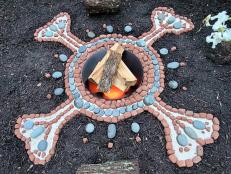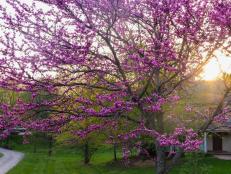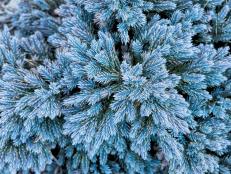How to Make a Rock Garden
Learn about the different types of rock gardens and how to design rock flower beds for drought-tolerant beauty in your yard.
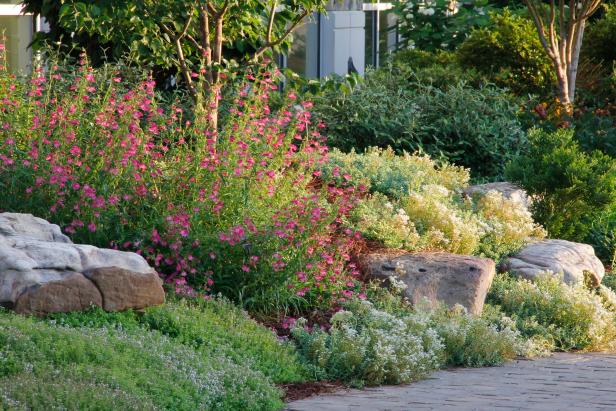
Image courtesy of The Fockele Garden Company

A rock garden is an outdoor landscaping arrangement that primarily features well-placed natural stones combined with stunning alpines and similar exquisite plants. Once established, many rock gardens are drought-tolerant and relatively low maintenance.
In This Article
Rock gardening is possible at any scale, from individual jewel-like flowers growing in tiny pots to recreations of stony cliffs studded with beautiful plants. Building a rock garden can be as involved or carefree as you choose, but be warned, it’s easy to get carried away!
What is a Rock Garden?
Defining the term “rock garden” sounds like it should be simple — it’s a garden with rocks in it, right? However, classic rock gardeners typically use a stricter definition of the term. A traditional rock garden is designed to mimic a stony, windswept, high-altitude environment where small alpine plants grow in pockets of lean, sharply drained soils.
The name “alpine” is a blanket term used to describe any plants that are naturally found growing above the timberline in mountainous regions. Rock gardeners treasure these plants for the way they've adapted to thrive in the most inhospitable environments. Alpine species modify their foliage to avoid water loss due to drought, exposure and wind. Leaves that are fuzzy, silver, small, dissected or succulent are all better able to cope with life above the tree line. Most alpines cling tightly to rock or soil, with their leaves and stems forming a low, creeping mat or snug bun. When it’s time to flower, alpines invest in showy blooms to help pollinators find their way.
30 Gorgeous Rock Gardens 30 Photos
These rock garden ideas will help you bring out the beauty of boulders, stones and rocks using lush and lovely low-maintenance plantings.
While alpines thrive in the most difficult growing conditions, they tend to suffer in traditional gardens that offer nutrient-rich soils that hold onto moisture. Simply put, alpines are better adapted to traditionally harsh environments than those we think of as temperate or hospitable. Rock gardeners study alpine plants’ native environments and do their best to replicate them in the landscape, both in terms of growing conditions and in appearance. As a result, many rock gardens look similar to a rocky outcrop, studded with alpine plants.
The idea that rock gardening is synonymous with alpine gardening has become more relaxed in recent years and many new gardens include species such as cacti and succulents, Mediterranean plants and ephemeral woodland plants that you wouldn’t find in a traditional rock garden. Rock garden designs have also changed by improving growing conditions for the plants without trying to mimic the appearance of a rocky peak.
Types of Rock Gardens
There are many types of rock gardens, and gardeners continue to experiment with new styles. A few of the most common techniques for rock gardening include naturalistic gardens, raised beds, rock walls and troughs or other containers. One consistent trend among these various techniques is elevation. Whether it’s grown on a slope, planted up a berm or in a raised bed or living wall, most rock gardens are usually elevated in some fashion to improve drainage and prevent moisture from pooling around plants. Elevating a rock garden also brings alpines and other smaller species closer to eye level, making them easier to appreciate and enjoy.
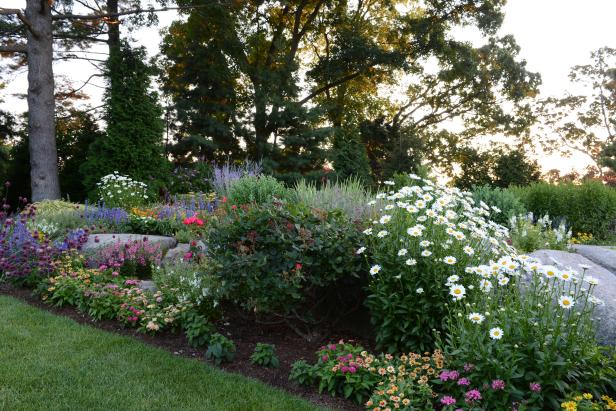
Image courtesy of Stacy Bass
Whether it’s grown on a slope, planted up a berm or in a raised bed or living wall, most rock gardens are usually elevated in some fashion to improve drainage and prevent moisture from pooling around plants.
Naturalistic Gardens
Many rock gardeners who have studied the places where alpine plants thrive have developed a variety of techniques that mimic those natural environments. Berms, crevices, screes and moraines are a few of the most popular methods for creating a rock garden that looks like it was taken right from the mountaintop to your yard.
Rock-studded berms (raised banks of soil) are probably the most common ways to grow a rock garden. In addition to providing excellent drainage, berms add dimension to flat sites and create privacy in exposed gardens. Rocks are embedded into the soil on the sides of the berm to give the impression of a rocky outcrop. Rock placement is key, and gardeners should consider size, directionality and spacing between stones.
Crevice gardening is a style that was originally developed by Czech growers. Crevice gardens recreate the conditions of a rocky outcrop rather than simply mimic the appearance of one. Much like an iceberg hides most of its body below the water, in a crevice garden, most of the body of each individual rock lies unseen beneath the soil. Plants live between the crevices in these rocks. Most alpines thrive in crevice gardens because they have excellent drainage and moderate soil temperatures. Stratified sedimentary rocks like limestone and sandstone are usually used for this style of rock garden when done on a large scale, but any type of flagstone will do. Even pavers will work for miniature crevice gardens.
Scree is a collection of loose, rocky stones and gravel at the base of a slope. These occur naturally as wind and water erode rock faces. Plants that thrive in a scree environment tolerate drought and extreme temperatures. A scree feature mimics this phenomenon by piling a mixture of free-draining gravel, grit or sand with garden soil on a berm or against stones. While scree mixtures are often used in conjunction with other garden styles, gravelly scree gardens are beautiful on their own.
Moraines are similar to screes in composition, but natural moraines are formed by glaciers. As glaciers melt, the water runs hidden from view below the soil surface, providing plant roots with a steady supply of cool water. This sort of environment is ideal for many finnicky alpine plants. Gardens that strive to recreate a moraine may look similar to scree gardens at first glance, but their construction is much more complicated, with an underground irrigation system recirculating cool water in the root zone below the garden bed.
Raised Beds
Raised beds are fantastic for rock gardens. By growing in a raised bed, gardeners have better control over soil quality and drainage, plants are elevated for easier viewing, and raised beds may fit better aesthetically with the home and rest of the landscape. Building a raised bed is relatively simple. While edging with rocks is attractive for a raised rock garden, it’s not a requirement for happy plants.
Planted Walls
Retaining walls and dry stacked walls lend themselves well to planting with rock garden plants. While existing walls can be modified to accommodate alpine plants, new walls that you intend to plant up should be designed with that plan in mind. Retaining walls should have a well-draining soil mixture about 4 to 6 inches behind the stones. Stones should be set at a downward angle so that water will run back and away from the face.
Containers
Many rock garden plants thrive in containers. Growing a small rock garden in a container allows for more control over the soil mixture, and if a plant is unhappy in one spot, the pot can easily be moved to a better location. Individual specimens will grow well in a single container, and deep, slender “long Tom” pots work especially well for alpines that have taproots.
The trouble with any type of container is that the plant’s root zone is more exposed to extreme temperatures and may be more likely to dry out. Container plants will need to be watered more frequently than their in-ground counterparts, and they may need to be protected from intense summer heat or winter cold.
Alpine specialists overcome these issues by partially burying pots in sand “plunge beds." The sand surrounding the container helps moderate soil temperatures and minimize water runoff. Individual pots can be set in a slightly larger pot of sand, or multiple pots can be grouped together in one large plunge bed.
Troughs made of rock or hypertufa are excellent for mini-rock gardens. In his book "The Rock Garden Plant Primer," Dr. Christopher Grey-Wilson estimates that a 6-foot by 3-foot container can hold 40 or more individual plants. If purchasing a new trough seems out of budget, it’s possible to create your own hypertufa container for a fraction of the cost.
How to Make a Rock Garden
1. Make a Plan
A rock garden can be a major investment in time, energy and money. It helps to brainstorm some ideas for your rock garden before you begin. If you’ve never grown a rock garden before, experiment by converting a small section of your garden and growing it over time. What type of plants would you like to grow? What area of the yard would you like to cultivate? What are the conditions in that area? Will you create a naturalistic, raised bed, planted wall or container garden?
A visit to an established rock garden is a great way to get ideas, and experienced rock gardeners are usually happy to share what they’ve learned. Reach out to your local chapter of the North American Rock Garden Society or explore a rock garden at a nearby botanic garden for inspiration. Also, see these examples.
2. Amend the Soil
Soil is the key to any successful rock garden, and unless you’re one of the favored few whose native garden soil is perfect for alpine plants, chances are that you’ll need to do some soil improvement. Your current soil texture, the larger environmental conditions for your region and the needs of the species you plan to grow will all ultimately factor into what soil recipe will work best for your garden.
If you’re planning to amend your existing garden soil, your first step should be to conduct a soil test. Most state extension services offer speedy soil testing that can tell you the sample’s soil texture (the percentage of sand, silt and clay), amount of organic matter, level of acidity or alkalinity and nutrient levels.
Rock garden soil mixtures typically include varying proportions of rock particles, sand and soil. Rock particles can be crushed gravel fines, pea gravel, small pebbles or even chicken grit (look for flint grit rather than oyster shell). Coarse builder’s sand works exceptionally well in rock gardening, but fine-textured masonry sand does not. The best way to decide what ratios will work well in your garden is to reach out to other rock gardeners in your region. Members of your local chapter of the North American Rock Garden Society or experts at a nearby botanic garden will be happy to help.
If you’re starting with a small bed, you can mix components yourself in a wheelbarrow or on a tarp. Larger projects may require a rototiller or front-end loader. If you’re ordering soil from a rock supplier, they may be able to mix everything up for you as they load the truck.
3. Place Rocks
Obviously, rocks play a central role in most rock gardens. Most rock gardeners try to limit themselves to just one material for a cohesive look, and sourcing a local stone will help tie your garden into the larger environment. Depending on the size and type of stone, you’ll probably need help moving rocks around. A good dolly or hand truck and a few strong friends will make all the difference!
Start placing rocks at the bottom of the bed and work up. Larger rocks will be more stable lower in the bed and they’ll provide support to the stones higher up. Keep rocks at an angle for better drainage and stability. If you’re building a crevice garden, be careful to keep the stones aligned. Firm in the soil around each individual rock as you work and use smaller shims for support to prevent stones from settling. Every single rock needs to be stable for long-term stability and safety.
Gardening in a container? You can still place rocks that serve decorative or functional purposes. Topdressing with attractive rocks adds interest to the pot and provides contrast to the plants. It’s even possible to create a small crevice garden in a large container. In his book "Rock Gardening: Reimagining a Classic Style," Joseph Tychonievich describes a rock gardener who uses rocks in containers to make plants more resilient. The gardener embeds long rocks that can reach the bottom of the pot as a way to train roots to grow more deeply and reduce water demands.

ProvenWinners.com
A mix of annuals and perennials pack a colorful punch in this hillside rock garden. Groundcover Mojave Tangerine purslane, Luscious Royale Piña Colada lantana and lemon coral sedum skirt taller Lakota Fire coneflower and Rockin’ Playin’ the Blues purple salvia. This easy-care combination supplies undemanding color all season long.
4. Add Plants
Now for the fun part! As a rule, alpine plants tend to establish better and survive longer when started from small plants, divisions or rooted cuttings. Inspect the soil mixture in the pot in which the plant has been growing. Specialty nurseries should grow their plants in appropriate soil mixtures; however, if plants are growing in moisture-retentive peat or other organic material, that could lead to problems in the garden and the mix should be carefully removed from the roots.
Excavate a hole along the surface of one of the rocks. Gently drop the roots into the hole, keeping them as straight as possible. Slowly refill with the soil that was removed, gently watering periodically as you work to fill any air pockets. Do not bury the plant too deeply. Keep the soil at the same level as it was in the pot. Surround the base of the plant with gravel or grit to prevent water from rotting the crown.
According to the North American Rock Garden Society’s "Rock Garden Design and Construction," Czech gardeners have a trick that will help finnicky alpines get established. Planting a carefree and shallow-rooted succulent like stonecrops (Sedum spp.) and hens and chicks (Sempervivum spp.) at the base of the new plant will help moderate soil temperature and protect the young plant from harsh weather.
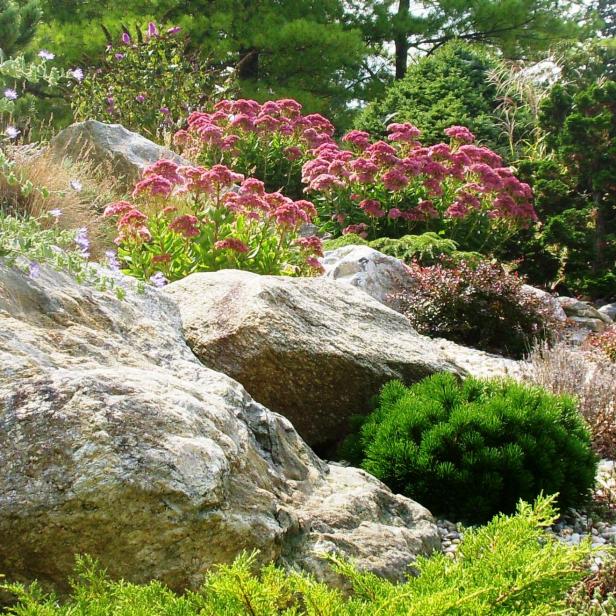
Bill Einhorn, RLA, LDAW Landscape Architecture PC
A dazzling collage of sedum plants make their home amid the imposing boulders of this all natural rock garden.
Alpine plants you could try in your rock garden include:
Keep an eye on water for the first year as plants become established. Depending on the species you are growing, the conditions in your garden and the environment in your area, the plants in your rock garden may not need any irrigation after the first growing season.

.-Battle-on-the-Beach-courtesy-of-HGTV.-.jpg.rend.hgtvcom.196.196.suffix/1714761529029.jpeg)





